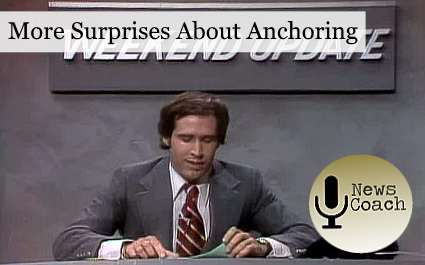News Coach: More Surprises About Anchoring
By Joanne Stevens

When last we met, we
discussed the most common roads leading to an anchor opportunity, and
dispelled some misconceptions. We will now tackle some of the most
frequently posed topics and questions I get.
“Do you watch [anchor’s name]? That’s the style I’d like to
learn. I like his tone.” This brings me back to my speech/language pathology days. I sometimes
worked with ‘on the spectrum’ young adults who wanted to sound more like
their non-spectrum peers. In this case we worked from overlays of ‘how
spoken language sounds.’ With regard to you and your anchoring: You will
each sound unique! Your natural speaking voice, and how you normally
interpret nuance and innuendo when you speak, will serve as your best
foundation. If some proclivities within your everyday speaking voice prove
to be distracting and in need tweaking, or if you may need to add a few new
tools to your kit (e.g. methods of emphasis), this will be apparent.
Otherwise, trust that you’ve come this far with the speaking voice you use
in your reporting. “What do I do with my
hands?”. The takeaway: There is no patented pose. Ahh, you do! You mark them ahead of time, planning on what you will
emphasize? Wrong! At this rate I’ll have my next book. But I am electing to stop here for
now so that you can please allow the above to gently seep into your
communication-driven minds and souls. Joanne Stevens News consultant Joanne Stevens has written extensively about broadcast
writing, reporting and anchoring, including columns in the former print version
of RTDNA's Communicator Magazine, and earlier versions of the RTDNA website. She
has taught at Columbia and New York University and serves as a news award judge
for the New York Press Club. She has returned to RTDNA.org to offer a new series
of News Coach columns with tips, best practices and more. - Click on
the RTDNA logo below to learn more. This blog was originally published here:
https://rtdna.org/article/news_coach_more_surprises_about_anchoring The takeaway: There is
no ‘one magical technique’ to aim for.
Um, what do you normally do with your arms and hands as you
speak? That’s most likely your answer. It’s easier to tell you what not to
do:
Warning: Trick question ahead! Did you mark your scripts?
You just need to quickly read through your script
once, internalizing the information. This includes your intellectual,
journalistic reaction to it. There is no anticipation about what your voice
or body language will do. Some of my clients will whiz through a script
muttering fast in sotto voice, but they are not ‘planning’ how to speak.
Then, wow! There it is in the prompter! This is what is in your head:
“Oh yeah, I wanted to share this, and want to share this too”. If you
underline individual words or put stars around them in the prompter, you’ll
‘oomph’ [patented term] individual words. This makes you sound like an
enthusiastic speaker of a litany of isolated words (I wonder if this is how
cavemen sounded) and we’ll be annoyed or lost. We talk in cognitive chunks.
Go for the whole message. It’s most often the entire sentence, or two chunks
per sentence.
Okay, you can mark your paper scripts, but here’s
where: Horizontal lines above and below your ‘reads’. And if you’re a team
player, you can do it with your partner’s part as well. There’s nothing
better in this world than a team player (you’ve hopefully already learned
this in the field). This way, when the prompter goes down – and it will –
it’s just a matter of time – you’ll have an easier time picking up from the
point where your easy world went dark. I’d use a thick nubbed pen or marker,
and as you anchor remember to move your pages along so that your top page or
page in front of you keeps current with the information on the prompter.The takeaway: You want to convey thoughts, not words.
To be continued, I promise!


